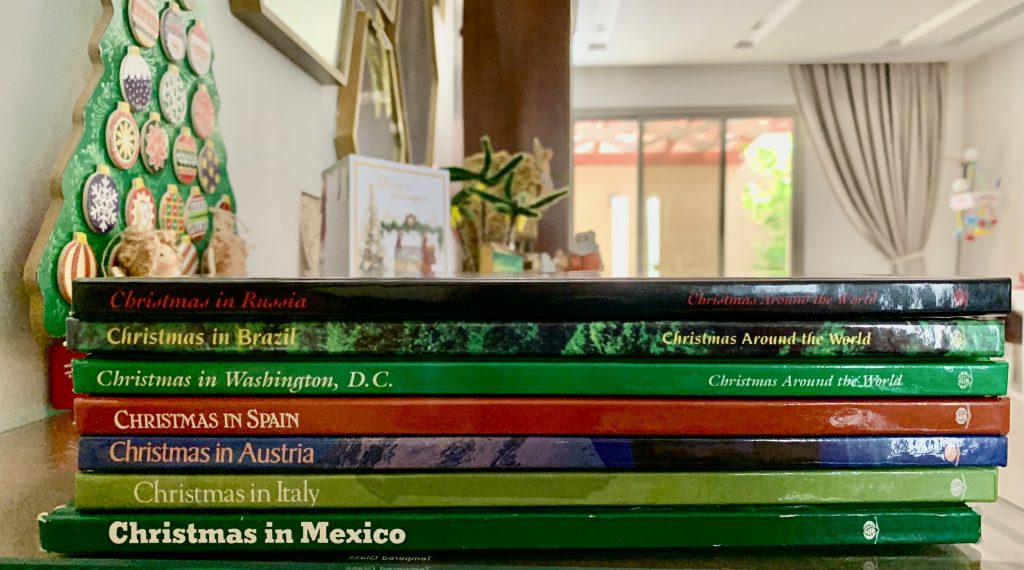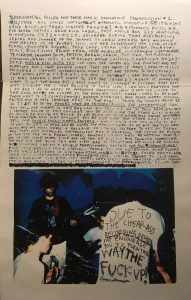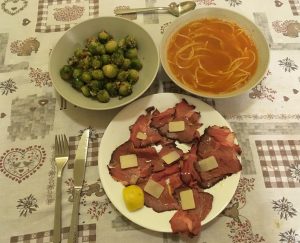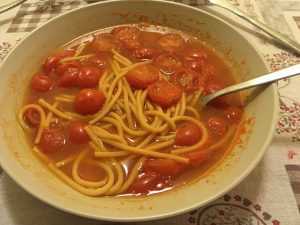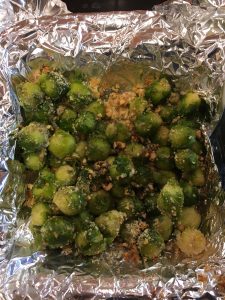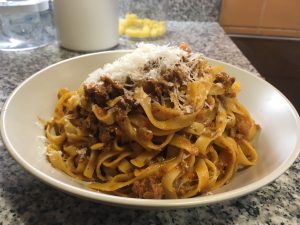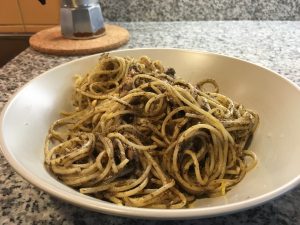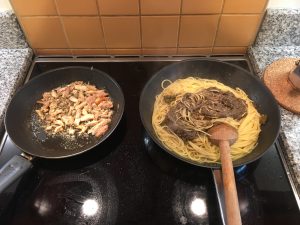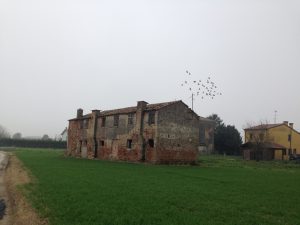I came across an essay almost a year old by one Mattias Desmet called “The De-Souling of the World.” It ends with these lines:
“This revolution essentially boils down to this: a society led by a propagandized mass is replaced by a society led by a group of people connected through sincere speaking. […] What are the different ways in which a person can use words, and which form of speaking can penetrate the veil of appearance and inspire people in times when they are suffocating under manipulation and appearance? How can we master the art of Good Speech?”
Which put to mind John Dos Passos’ “Sacco and Vanzetti” passage from U.S.A., (The Big Money, 1936), Camera Eye 50:
“America our nation has been beaten by strangers who have turned our language inside out who have taken the clean words our fathers spoke and made them slimy and foul”
It also recalls these quotes found in Lionel Trilling’s Sincerity and Authenticity (1972):
“Born Originals,” Edward Young said, “how comes it to pass that we die Copies?” (p. 93, Oxford University Press edition)
“The machine, said Ruskin, could make only inauthentic things; dead things and the dead things communicated their deadness to those who used them. Nor, in his view, is it only actual machinery which produces dead objects but any mode of making that does not permit the maker to infuse into the artefact the quality of his being.” (p. 127, Oxford University Press edition)
With thanks to Shirty Sleeves’ “Constellations” series for the inspiration.
Big and Bad
Recent events — or the media imagery thereof — put in my mind an old Thomas Pynchon article, “Is It O.K. To Be A Luddite?” from nearly forty years ago. There’s a photo that could go with this, but it’s far too obvious, so you’ll have to settle for Kong. For readers interested in the continuing re-evaluation of the Enlightenment, I would draw your attention to the third quote. But I’d paraphrase further by saying that turning to the hulk means denying the machine, which means a chance for the earthly ones to take part in the transcendent.
There is a long folk history of this figure, the Badass. He is usually male, and while sometimes earning the quizzical tolerance of women, is almost universally admired by men for two basic virtues: he is Bad, and he is Big. Bad meaning not morally evil, necessarily, more like able to work mischief on a large scale. What is important here is the amplifying of scale, the multiplication of effect.
[…]
What gave King Ludd his special Bad charisma, took him from local hero to nationwide public enemy, was that he went up against these amplified, multiplied, more than human opponents and prevailed. When times are hard, and we feel at the mercy of forces many times more powerful, don’t we, in seeking some equalizer, turn, if only in imagination, in wish, to the Badass – the djinn, the golem, the hulk, the superhero – who will resist what otherwise would overwhelm us?
[…]
The Methodist movement and the American Great Awakening were only two sectors on a broad front of resistance to the Age of Reason, a front which included Radicalism and Freemasonry as well as Luddites and the Gothic novel. Each in its way expressed the same profound unwillingness to give up elements of faith, however ”irrational,” to an emerging technopolitical order that might or might not know what it was doing.
[…]
To insist on the miraculous is to deny to the machine at least some of its claims on us, to assert the limited wish that living things, earthly and otherwise, may on occasion become Bad and Big enough to take part in transcendent doings.
—
The Fall had a song about Ned Ludd, too, called “Ludd Gang,” a b-side to “The Man Whose Head Expanded” from their wonderful 1983 two-drummer period. I wonder what Mark E. Smith would think of the current contest in America. “Ludd Gang” has a little dig on Gang of Four which MES explained in a 1981 interview in SPEX Magazine.
S: Why don’t you like the Gang of Four?
Mark: Because their songs are about politics. They preach the leftist ideas. They went to University and belong to the privileged class. The problem is that they pretend to know what the working class wants. But they haven’t got a clue. Sham 69 however knew what they were talking about and they were good. The English working class (including myself) find the music of the Gang of Four offensive, insulting, hurtful. I listed to their first singles a lot in those days. Later on I saw them live, too and then you could tell they lacked the feeling when they got to the heart of the matter. I mean, how could they talk about problems and changes in the world when they play like that. Maybe I am being cynical but it’s more important to me to be honest to myself. I don’t like the music of the Gang of Four. I prefer rock’n’roll bands.
Finally, I’ll point out a Gang of Four song that’s also topical and leave it at that.
Christmas Around the World
Every year during my childhood, our post box was graced with an 80 page volume of one of the World Book’s Christmas Around the World series, a gift, I think, from my globetrotting grandparents. Although somewhat dated and with some breathlessly misleading information (the Spain entry insists that Spaniards eat loads of turkey for Navidad, but that it’s stuffed with garlic and glazed with olive oil, and the Washington volume seems to describe a city that hasn’t existed for a good century or so, and possibly never did), they’re still wonderful glimpses into the habits of other countries at Yuletide. At the very least they inspire curiosity, which I’d like to think has something to do with why I can vouch for how Christmas is passed in the locales of at least five of the books on the below list. I hunted in vain for a decent list online, and failing to find one, decided to post the below, which I’ve verified with family members who still have the books. I have a few of them in my possession myself (pictured). It seems the series went on for another decade, till at least 2003, when probably — like so many other good things in the past — someone decided that the internet did a better job with “information.” But those who had these colorful volumes know the truth. A reader who knows the series very well writes in to note that the books “also arrived with an advent calendar, small ornament, and recipe cards. A family could celebrate Christmas around the world!”
- 1993 — Germany
- 1992 — Russia
- 1991 — Brazil
- 1990 — The Philippines
- 1989 — Poland
- 1988 — Washington, D.C.
- 1987 — The Holy Land
- 1986 — Denmark
- 1985 — Ireland
- 1984 — New England
- 1983 — Spain
- 1982 — Austria
- 1981 — The Netherlands
- 1980 — France
- 1979 — Italy
- 1977 — Scandinavia
- 1978 — Britain
- 1976 — Mexico
Given the paucity of information out there about the series in general, for the completist I’ll add the below list. I don’t actually own any of these (although I wish I had the Belgium one, at least), but these are the fruits of the some internet labor, mainly thanks to ThriftBooks.com. There appear to be a couple of duplicates, or possibly some of the copyright dates are wrong.
- 2003 — Puerto Rico
- 2002 — Belgium
- 2001 — Scotland
- 2000 — Greece
- 1999 — Finland
- 1999 — Australia
- 1998 — The Phillipines
- 1997 — Ukraine
- 1997 — Colonial and Early America
- 1996 — American Southwest
- 1995 — ?
- 1994 — Switzerland
- 1994 — Canada
On Neutrality and Great Powers

From Henry Adams’ Education of Henry Adams:
Minister Adams felt the same compulsion. He bluntly told Russell that while he was “willing to acquit” Gladstone of “any deliberate intention to bring on the worst effects,” he was bound to say that Gladstone was doing it quite as certainly as if he had one; and to this charge, which struck more sharply at Russell’s secret policy than at Gladstone’s public defence of it, Russell replied as well as he could:–
… His lordship intimated as guardedly as possible that Lord Palmerston and other members of the Government regretted the speech, and Mr. Gladstone himself was not disinclined to correct, as far as he could, the misinterpretation which had been made of it. It was still their intention to adhere to the rule of perfect neutrality in the struggle, and to let it come to its natural end without the smallest interference, direct or otherwise. But he could not say what circumstances might happen from month to month in the future. I observed that the policy he mentioned was satisfactory to us, and asked if I was to understand him as saying that no change of it was now proposed. To which he gave his assent….
Minister Adams never knew more. He retained his belief that Russell could be trusted, but that Palmerston could not. This was the diplomatic tradition, especially held by the Russian diplomats.
Let’s imagine Yellen had a personal financial interest in Russia holding on to Ukraine and had made public comments to that effect, and update the passage for these Top Gun times.
Ambassador Oksana Markarova felt the same compulsion. She bluntly told Blinken that while she was “willing to acquit” Yellen of “any deliberate intention to bring on the worst effects,” she was bound to say that Yellen was doing it quite as certainly as if she had one; and to this charge, which struck more sharply at Blinken’s secret policy than at Yellen’s public defense of it, Blinken replied as well as he could:–
… The Secretary intimated as guardedly as possible that President Biden and other members of the Government regretted the speech, and Ms. Yellen himself was not disinclined to correct, as far as she could, the misinterpretation which had been made of it. It was still their intention to adhere to the rule of perfect neutrality in the struggle, and to let it come to its natural end without the smallest interference, direct or otherwise. But he could not say what circumstances might happen from month to month in the future. I observed that the policy he mentioned was satisfactory to us, and asked if I was to understand him as saying that no change of it was now proposed. To which he gave his assent….
Ambassador Markarova never knew more. She retained her belief that Blinken could be trusted, but that Biden could not. This was the diplomatic tradition, especially held by the EU diplomats.
Rebutting Radical Chic…nella Cucina Italiana
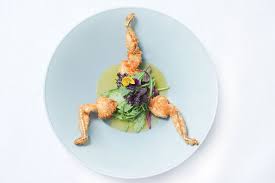
In a fit of radical chic, the Financial Times published Marianna Giusti’s interview with Marxist academic Alberto Grandi, in which the latter “debunks” (a popular activity these days) Italian food traditions, most of which are admittedly as new as Italy’s prosperity. It’s not a difficult task to take on if one has read more than online articles or cookbooks published in the last decade, and Grandi is, generally speaking, correct. But he undertakes his task with the zeal most debunking Marxists have, relishing the zingers and gotchas of slaughtering sacred cows. But where’s the beef? A few thoughts below.
Those who have followed Italian food writing for any decent length of time will also have read a few of Giusti’s lines before — but at least she has a roster of nonne and zie to call.
Italy was a poor country before the Second World War — of course no one could afford rich foods loaded with meat and cheese then. Spain is similar, of course, and I was baffled at some of the veggie-free and meat-heavy dishes on offer in Madrid a few years ago. Those of us with octogenarian Italians in their lives know that in the old days everyone just ate beans, soups, root vegetable, and, of course, bread. All the stale bread recipes! And if you don’t, you can read about it a book like La Luna e i Falò where the Piemontese peasants eat that stuff. Even in A Farewell to Arms it’s clear pasta and cheese is a big wartime luxury, although the wine is omnipresent in Pavese and Hemingway both. Primo Levi writes about fantasizing about pasta when he’s in Auschwitz.
My old haunt, Veneto Sud, is still especially strong on the soups, veggies, and stale bread menu. Maybe a few shellfish thrown in near the coast, and of course, polenta, especially the more north you go. Affettati sliced agonizingly thin to make the pork last all winter. Until recently, my Veneta (DOC) mother-in-law had never had a piadina. For my father-in-law, born in 1925, colazione was stale bread and coffee. Brioche? Mai.
It was educative for me to go to rural Balkans (which was still poor two decades ago) before Italy for see what pre-war other parts of southern Europe were like — many similar southern European food traditions, albeit with a Turkish spin, still being practiced. Most remarkable? The fridges were tiny. Not much industrial food to go in them. Basements for cans and bottles, other stuff fresh. A freezer for the annual pig slaughter.
I take some umbrage with the grouchy and puritanical Marxist point of view (also why is FT interviewing a Marxist?) that “everything dear to you is a lie, there are no traditions [left unsaid: there’s only oppression!].” These so-called debunkers are joyless, and I can’t stand Eric Hobsbawm and his quotidian ideas dressed up as something fancy. Married with the FT‘s typical neoliberal ultra-capitalist ideas that we’re all just postmodern blanks slates and life constantly mixing stuff up, it’s even more noxious.
Having said all that, I support syncretic traditions if they celebrate life and goodness. For example, I love Washington’s national mall, even if all the designs are obviously not “authentic” (taking inspiration from the same Palladian villas that dot the Veneto) and it’s a sort of a patriotic Vegas imbued with national character. “Italian” food is much the same and if impossibly rigid recipes in our time of plenty give people what they want, why not? Three cheese chicken tortellini are not to my palate anyway, so I don’t mind someone yelling about the right way to make them.
Finally, as a matter of adopted Chesapeake pride, I reserve the right to jones for at least three items which can’t (or shouldn’t) be found in modern Italy: a proper Baltimore Italian cold cut sub, meatball sub or pizza cheese steak (which I learned when I moved to Italy is a bistecca al pizzaiolo on a sub roll) — although I’m pretty sure all the Italian corner joints, still there in the nineties, are falafel shops by now. But I’ll only eat ’em in Bawlmur, hön.
Long Live the Experimental Pollen
Back in 1996, fans of lo-fi music, Crain, and Louisville’s particular brand of homegrown rock might’ve been following Experimental Pollen, a short-lived Jon Cook project. As it looked like Crain was about to split up, that small community might’ve paid particular attention to what a possible Crain follow-up would be. Experimental Pollen had a pretty mighty presence that summer, with a crack rhythm section composed of Troy Cox (Evergreen) and Will Hancock (Four Fifty Six), but the very few released recordings never really measured up to that lineup, and the band folded as Jon got more interested in noise music and his decline began to inexorably take hold.
However, before all that, he managed to release a 7″ EP on the one-off Gene Rick label (sporting a St. Cloud, Minnesota P.O. box for reasons that remain obscure to me). Essentially a split with New England indie rocker Mike Flood (also obscure), I got my hands on a copy of it recently and am pleased to post the two best solid songs from it, both recorded in “that electrifying spring and summer of ’94.” I’ll second the electricity.
To cop from the liner notes, “long live the Experimental Pollen! Happy!!!!”
***UPDATE: I’ve added a couple more Experimental Pollen songs to the playlist so readers/listeners don’t have to jump around the links in the last sentence of the first paragraph.
M&M Enterprise Cooking, Vol. XIX
Here’s a pre-Thanksgiving Day meal complete with primo, secondo and contorno. I was most excited about the contorno and had been squirreling away supplies from the dining facility for some time for it. The primo, a dish more suited to Italy’s hot summers, came out surprisingly well, and the primo, a simple soup, rounded it out. I liked this meal so much I had it twice yesterday — or was it just that I had leftovers and it was easy to allungare the soup a bit? One or the other, let’s say.
Primo — zuppa trapanese all’aragosta
This one was made easy by Better than Bouillon lobster base. Of course the actual recipe from Trapani calls for catching one’s own lobster and then making decorative use of the claw, but here there’s that whole piddly detail of being 1400 km from the nearest port.
Simply boil water, add a tablespoon of the base, break some spaghetti up and toss it in (correct that breaking is never done, but this is a soup). I added a garlic clove and for the dinner version several cherry tomatoes. You can also put in a spot of tomato paste, or, since I didn’t have that, some tomato passata.
Secondo — roast beef all’inglese
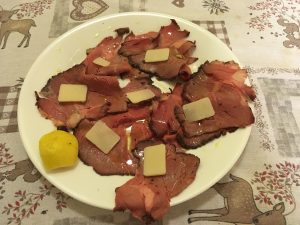
Also very easy and made possible by the rare (pun intended) appearance of roast beef at the local sandwich bar. Spread out and arrange the slices, dress with juice of a fresh quarter lemon, good EVOO, S&P, and thin slices of a grana-type cheese (I used grana padano). Cherry tomatoes are a nice addition; arugula usually works wonders, but the dining facility had run out mere seconds before.
Contorno — cavoletti di bruxelles gorgonzola e noci
I found this recipe when researching how to to do a perfect pasta with gorgonzola and walnuts, and it makes use of both to liven up the kiddie favorite of Brussels sprouts. This required a bit (but not too much prep).
There is absolutely no gorgonzola here, so bleu cheese crumbles have to work.
I swiped a roll from the salad bar awhile back, let it go stale, and then it nicely crumbled into fine dustings of bread crumbs.
Big shelled walnuts are usually around, so I diced up some of those finely. (Leftover crushed nuts go well with yogurt and honey.)
By some miracle, one of the few non-depleted stocks at the Italian PX is butter from Udine. They have gobs of it.
Pre-heat the oven to 200C and use an option that gets some heat from above, as you’ll want a nice crust. (If you have a broiler, broil at the end.)
Prep the above, boil your sprouts, and drain them. As you’re transferring them into Pyrex, clarify the butter in the still-hot pot you boiled them in. Combine the breadcrumbs, cheese, nuts and clarified butter with the sprouts, give them a twist with a spoon to distribute the toppings, and bake for 10 minutes.
Eccola! There’s a pre-Thanksgiving feast worthy of the birthday of the prophet, peace be upon him.
M&M Enterprise Cooking, Vol. XVIII
Ragú Redux
Ragù. Pride of Emilia-Romagna, the rich, wine-and-broth simmered stuff which is indescribably comforting on a cold, foggy day in the Valpadana. And of course, a testament to its inherent goodness is its bastardization worldwide as “meat sauce” or, in an attempt to put an “authentic” spin on it, “bolognese sauce,” or, even worse, “salsa bolognese,” which is simply wrong since a salsa in Italian is something entirely different. But I don’t begrudge the triers — if I did, I won’t be able to write this post, or eat as well as I have, twice lately.
On “Italian nights” the dining facility (DFAC) makes, of course, “meat sauce” — seems like alloro (bay leaf) and erba cipollina (chives) are key ingredients, based off of sight alone (I haven’t tasted it in its “unimproved” form). What I’ve done is ask for a heaping helping of the stuff which I then freeze and re-do in an appropriately Bolognese way. (It’s hard to get fresh ground beef out here.) I’ve been happily surprised both times.
NB: In our household in Italy, we use mamma’s (and hence her mamma’s) time-honored recipe, which is a little different than the classic ragù bolognese, and it’s on that traditional dish that this recipe is based. As I said before, Veneto Sud has the advantage of being sometimes like Emilia-Romagna, sometimes like Veneto. Best of both worlds.
First, thaw the sub-standard ragù the night before.
Make a soffritto of butter (thanks to the Italian PX, I have butter from Udine), EVOO, and finely diced celery, carrots and onions. (Celery and carrots nabbed from the salad bar at the DFAC, onions bought for me on the economy.)
After the vegetables have softened a bit, add the sub-standard ragù. (In a normal recipe one would add the ground beef and/or veal/pork at this point and brown it.) Mix well, careful not to let it burn since it’s already cooked.
Add some white wine and let it evaporate. This is crucial.
Add nutmeg (Indian stuff, sourced from Amazon — coals-to-Newcastle irony not lost on me) and rosemary.
Add a couple cups of beef broth. I had pre-fab gelatinous cubes from the Italian PX which I added to boiled water, although I’m expecting some “Better than Bouillon” beef base soon.
Turn up the heat a bit (depending on one’s timeframe — I had an afternoon meeting so couldn’t let it simmer for hours) and let the broth boil off. Pay attention to sticking and burning potential.
In the meantime, one should be boiling water, salting it liberally, and putting in some tagliatelle which are the only acceptable kind of pasta to eat with this dish. (Unless one is making lasagne, and one could make an exception for real tortellini bolognese, but one should never add southern pasta forms like bucatini and absolutely no spaghetti, please, never, no.) They should be made with egg. They’ll likely be ready in under five minutes.
Once the sauce is relatively dry, mamma taught us to add a lot of grana padano or parmigiano-reggiano and stir it in. (One can, and should, grate some over the complete dish later.)
Toss the pasta well with the ragù (eliminating this step is also not an option.)
Add more cheese and eccola, one has oneself a meal that at least begins to resemble what’s on Sunday plates all over Emilia-Romagna and Veneto Sud. It might even come close to Trattoria Annamaria on via Belle Arti, one of my favorites spots for cucina bolognese.
And thus plain old dining hall “meat sauce” was reborn, made anew and rescued. One may note that I didn’t add any extra tomato — the pre-made stuff already had enough, and one characteristic is that real ragú usually has nothing more than a nominal dash of tomato paste.
There was a chili cookoff today, and I felt slightly guilty for not going as friends of mine were competing, but I took solace in the fact that ragù is like chili in a couple of ways — beyond both being simmered meat dishes, everyone’s mom has a recipe, and everyone’s mom makes the best version of it.
Here’s how my suocera’s version differs from the traditional one:
No pancetta, chicken livers, mortadella or other salty meaty additive with the soffritto.
White wine, never red.
Grana instead of whole milk at the end.
Thinner passata instead of tomato paste.
Addition of rosemary and nutmeg, which some people have strong opinions about, but I’ve got used to it and quite like it.
M&M Enterprise Cooking, Vol. XVII
Pasta con tapenade e sgombro
It was “Italian night” at the dining facility the other night so I picked up a vat of black olive tapenade, thinking I’d do something with it later, despite the fact that tapenade is a Provençal, not Italian dish, but why not? Surely there is some kind of Mediterranean goodness there to unpack.
I uncovered a recipe at Giallo Zafferano that somehow had all easily-obtainable ingredients — canned sgombro (mackerel), hot peppers, EVOO, garlic, white wine and parsley. As it ended up, I completely forgot a dash of frozen parsley, but with a bit of lemon zest, it was excellent anyway. As usual, high-quality Granoro spaghetti, mackerel and EVOO from the Italian PX made this dish better. If you’re dealing with pre-fab tapenade then this dish is even easier.
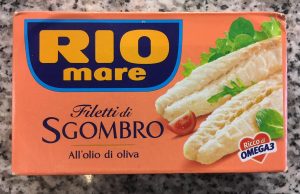
Steps:
Put on water for the spaghetti to boil in. When it comes to a boil, liberally salt it. When it re-boils, put in your spaghetti. While this is going on you can prepare the condimento.
Heat up some EVOO in one pan, toss in a garlic clove. While that’s heating, cube your mackerel. Toss it in once the garlic is browned. (Warning: it will splatter and pop, so adjust the heat accordingly, or pull the pan off the heat when you put in the fish.) Let the mackerel brown. Add salt and black pepper as you like, don’t forget the parsley, and then a dash of wine. Let the wine cook off and then take it off the heat.
Use a separate pan to make a soffritto of EVOO and spicy pepper. Giallo Zafferano has a fresh cut one, but I have some pepper spread I made here, so I threw in a teaspoon or two of that. You could probably get away with dried red pepper, too, but those burn very easily, so attenzione.
I was tempted to do all this in one pan, but I find that small details in a lot of Italian cookery — especially the simpler dishes — matter a lot. So just resolve yourself to washing more dishes. Use a big pan, too, because you’ll mix your pasta in this.
When the pasta is almost done, drain it, toss it in the pepper/EVOO soffritto, mix in the tapenade, and once it’s well-mixed, add your mackerel soffritto. For an extra touch of civility, take out the garlic clove at this point — its work in seasoning your soffritto is done.
Mix the whole thing well. At this point you can very finely grate some lemon peel over it.
Eccola, there’s your spaghetti con tapenade e sgombro.
One word of warning — either lower the heat on the pepper/EVOO pan or work very quickly. You don’t want the pasta to get too dry or fried-seeming.
If you can read Italian, don’t miss Giallo Zafferano’s evocative write up of Provence. If you can’t, a rough translation follows:
Picturesque landscapes, sunny coasts and the blue sea: these are some of the characteristics of Provence, a land famous not only for its endless lavender fields but also for its centuries-old olive trees. We were inspired by the landscapes of this French province to compose this tasty first course.
“San Martino, ogni mosto diventa vino”
Republishing this for the 103rd anniversary of Armistice Day —
It’s not only the 100th anniversary of Armistice, now Veterans, Day, it’s also San Martino, an autumnal feast day in Italy that celebrates not only the fourth-century patron saint of beggars, but also the maturation of new wines. The great Giosuè Carducci also wrote a poem describing a typical foggy fall day around this time of the year in northern Italy, which deserves quoting in full and in the original.
La nebbia a gl’irti colli
piovigginando sale,
e sotto il maestrale
urla e biancheggia il mar;
ma per le vie del borgo
dal ribollir de’ tini
va l’aspro odor de i vini
l’anime a rallegrar.
Gira su’ ceppi accesi
lo spiedo scoppiettando:
sta il cacciator fischiando
su l’uscio a rimirar
tra le rossastre nubi
stormi d’uccelli neri,
com’esuli pensieri,
nel vespero migrar.
[click on the title for a serviceable translation]

Carducci moved to Bologna at age 25, where he surely became acquainted with the pervasive northern Italian nebbia, which gets more intense the closer one goes to the Po.
While there, he lived on via Broccaindoso, where, it bears mentioning, there is a pretty decent osteria, if you’re in the neighborhood.
With thanks to SE for reminding me of all of this, and for introducing me to his poetry.



